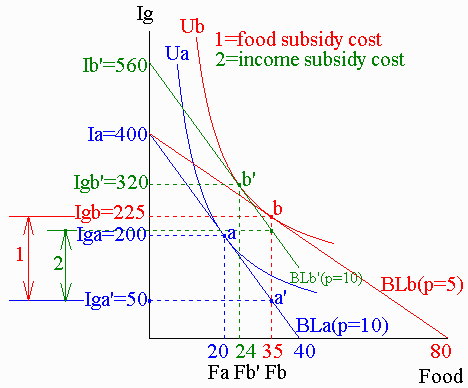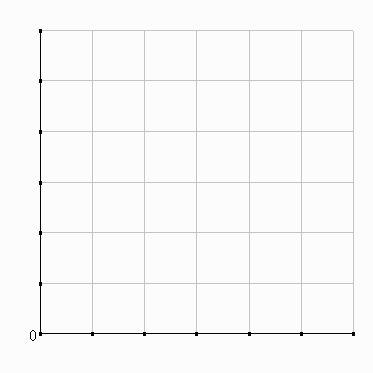Per student amounts in year 2010:
(1) Total expenses: 48,625
(2) Tuition and fees: 38,935
(3) Subsidy: 9,690
BLa: Without subsidy
BLb: With subsidy

|
Friday, February 22, 2013 |
II. Consumer demand
B. Extensions and
applications of consumer theory
4. Policy
applications
| Ex.2: Oxy education:
Per student amounts in year 2010: (1) Total expenses: 48,625 (2) Tuition and fees: 38,935 (3) Subsidy: 9,690
BLa: Without subsidy |
 |
| Note: The Qx with the subsidy might be so high that you have to extend the BL excluding the subsidy below the horizontal axis to illustrate the subsidy cost to the government. | |
In general, the policy impact of taxes and subsidies on good X
= the vertical distance between the old and new BLs
measured at the
new Qx.
Policy application 1: Comparing price and income subsidies
Policy option 1: subsidize food prices
| Consider a low-income family: Consumes food and other goods. Allow plenty of room to work to the left of the diagram.
a = no subsidy Now suppose the government offers food stamps which lower the family's price of food to $5. ? What happens to the BL y-intercept? |
 |
b = $5 per-unit food price subsidy
I Pf Qf Ig
b 400 5
35 225
(1) Government cost
of the food price subsidy = $5 x 35 = $175
Policy option 2: a utility-equivalent income subsidy
How
much would the government have to spend on a
utility-equivalent income subsidy compared to the price subsidy?
It's smaller
The government can just give extra income instead.
? In that case, how would you show the budget
line the family would need to reach Ub at market prices?
b' = utility-equivalent income
subsidy
I Pf Qf Ig
b' 540 10 24 300
(2) Government
cost for a utility-equivalent income subsidy
= the vertical distance between Blb' and BLa.
Utility-equivalent income subsidies are cheaper than price subsidies.
See Worksheet
But notice also that the family consumes less food
than with the utility-equivalent price subsidy. That's due to the substitution effect:
since food is more expensive along BLb' than Blb, the family consumes less food.
Note1: The cost of government programs of product-specific
subsidies such as food stamps tends to overstate the value of the subsidies to
the beneficiaries. This makes it difficult to determine the true impact of
government programs on income redistribution.
Note2: The 'right' choice of policy depends on the
goal. To specifically boost food consumption to quantity Fb, use a food price subsidy, but
if the goal is just to raise the family's welfare to Ub, then use an income subsidy.
Note3: Self-test: try taxes instead of subsidies and
contrast the effects of a product tax versus an income tax
| Policy application 2:
Taxes and rebates
(see
example
(Java)) Mankiw's blog: Thursday, February 05,
2009 My Preferred Fiscal Stimulus Characteristics of final new optimum:
|
 |
|||||||||||||||||||||||||||||||||
|
||||||||||||||||||||||||||||||||||
Final comments regarding consumer theory:
For more practice:
Worksheet
of applications
In many cases, the usual old demand curve does well enough, but it has
limitations, and the set of tools used for consumer theory allows us to do a better job.
They...
Resolve possible contradictions (Giffen goods, cross-price
elasticities)
Increase precision (CV and true change in CS)
Extend the range of questions we can tackle (price vs. income
subsidies)
Highlight consumer choice and the trade-offs between products--and
that's what econ is about, choice and trade-offs